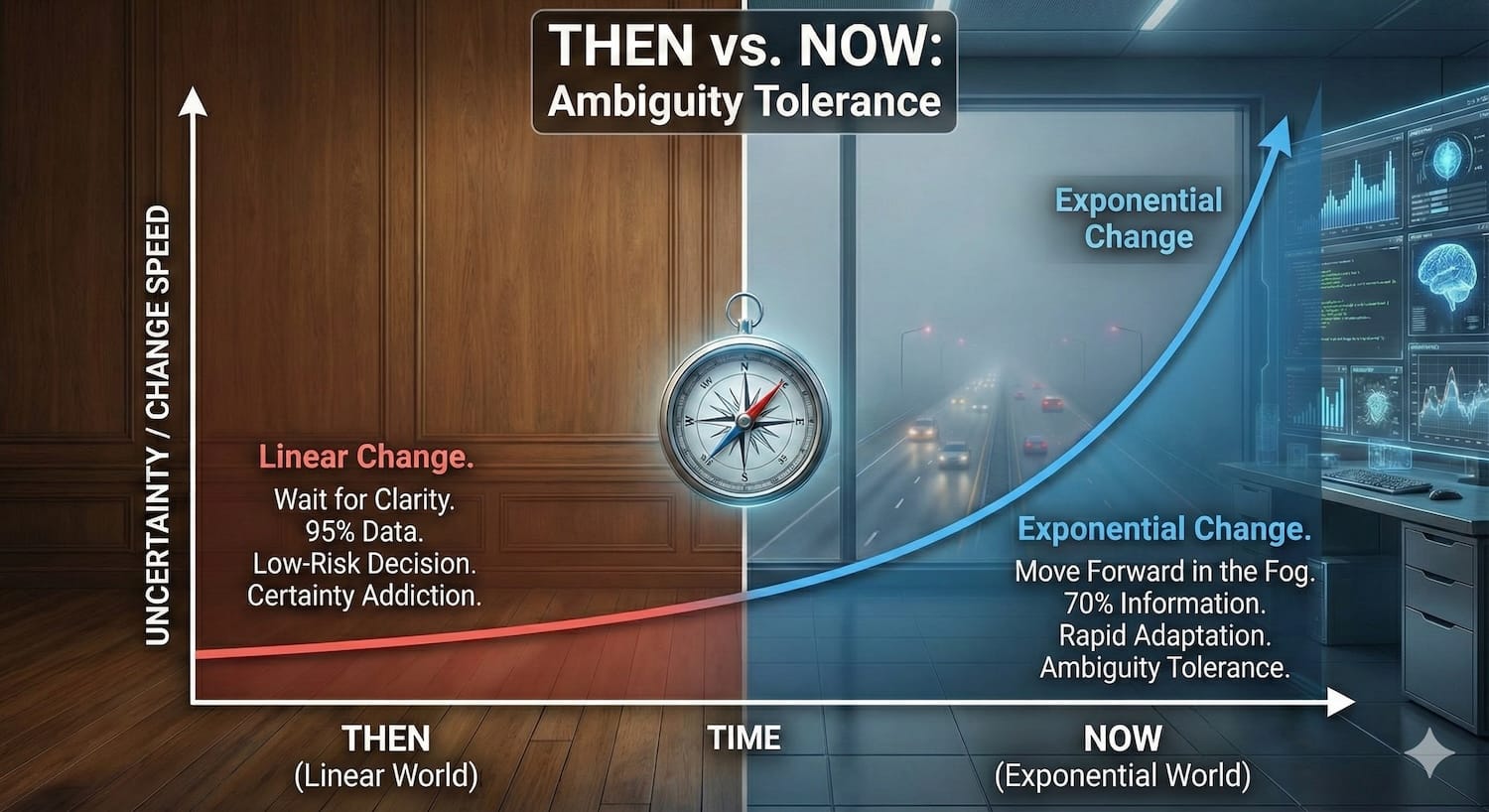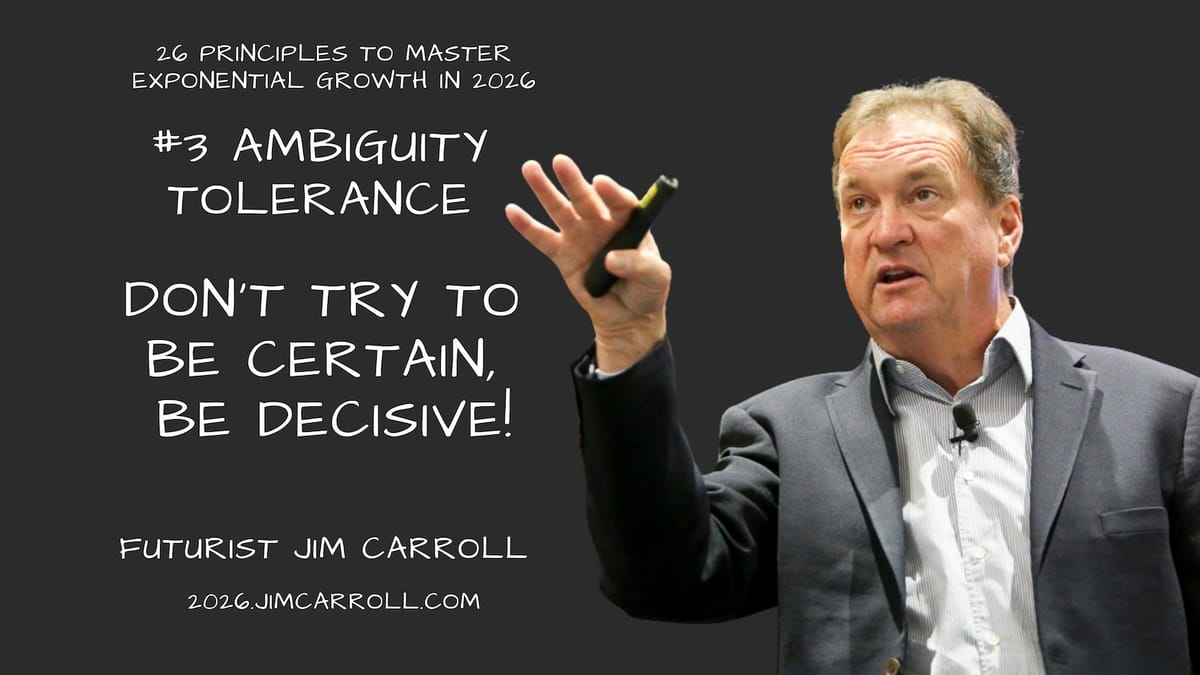"Don't try to be certain, be decisive." - Futurist Jim Carroll

Futurist Jim Carroll is writing his end-of-2025 / introduction-to-2026 series, 26 Principles for 2026. You can follow along at 2026.jimcarroll.com. He welcomes your comments.
If Day 1 was about seeing the speed of the future, and Day 2 was about clearing the path, Day 3 is about finding the courage to walk it.
Particularly when you don't know what the hell is going on. Welcome to 2026!
Here's the thing about where we are today - in a linear world (aka "the olden days", say, 2 or 3 years ago), you could wait for clarity. You could gather 95% of the data, build a perfect consensus, and then make a low-risk decision.
That world is gone.
Today, the speed of change outpaces the speed of data collection.
You need to learn to make decisions despite a wild lack of clarity, a stunning amount of uncertainty, a scary amount of volatility, and a staggering degree of velocity.
Think about just a few of the things that are going on in our exponential world at this very moment, at a macro-industry level:
- Energy: Suddenly, tech giants need gigawatts of power *right now* for AI, but building transmission lines and capacity historically takes decades. Do you build a data center hoping the grid catches up, or do you bet on unproven mini-nuclear reactors? This was exactly the type of scenario I was addressing in a keynote for executives in the sector just a few weeks ago in Tucson.
- Manufacturing: We know there are big opportunities in advanced robotics in ways that we can only begin to comprehend. Yet, should a factory invest millions in today's robotics, only to potentially see the exponential development of humanoid robots render them obsolete in but a few years, long before the machinery is paid off? Do you automate now and risk obsolescence, or wait and risk uncompetitiveness?
- Healthcare: AI diagnostics can spot diseases human doctors miss, but the legal frameworks for liability are years behind. Do you trust the AI and risk a lawsuit if it's wrong, or ignore it and risk negligence if it's right? Do you deploy now, or wait for things to catch up?
Now take these big, industry-scale trends which lead to ambiguity of decision making, and think about what is happening to you or the people around you on a daily basis.
- The "Mid-Career" Crisis: A mid-career marketing professional knows AI is changing their field, but it's unclear how fast and in what specific ways. Do they invest dozens of hours learning current AI tools (like Midjourney or ChatGPT) that might be obsolete in a year, or do they double down on "human" skills like strategy and relationship-building, hoping that's enough to stay relevant? The ambiguity lies in not knowing which path leads to future employability versus wasted effort.
- The "Student's Dilemma": A university student is in the midst of taking a major degree, say in accounting and finance. I just had this situation yesterday with a young fellow who sent me an inquiry on LinkedIn! They hear about AI automating coding, writing, and financial analysis. Do they pursue a traditional degree in finance, fearing their skills will be devalued by the time they graduate? Or do they choose a more "creative" or "interpersonal" field, with less clear career paths, hoping it's more "AI-proof"? The lack of clarity about future job markets makes this fundamental life decision paralyzingly uncertain.
- The "Freelancer's Fear": A freelance graphic designer sees AI generating impressive images in seconds. Do they lower their prices to compete with AI, try to pivot to a high-end "premium" service that emphasizes human touch and strategy, or attempt to become an "AI-augmented" designer? The volatility of client expectations and the velocity of tool development make it impossible to know if their current business model will exist in six months.
Take a look around - everyone is faced with big fast change, and don't know what to do about it! We've become a society of deer in the headlights, staring at the bright lights of oncoming exponential change, and yet don't know how to move out of the way - or jump right into it. (Weird metaphor, I know!)
Here's the thing - In every sector, the core uncertainty is the same: Trends are moving exponentially faster than our linear ability to regulate, build, or adapt to it.
If you wait for perfect clarity in this environment, you are waiting for a moment that will never arrive!
The discipline required to thrive here is Ambiguity Tolerance, and it looks like this.

It's about learning to live with the fact that there is no certainty, will never be any more clarity, and that you will be surrounded by ambiguity - and you decide to move forward with that being your new reality!
In that context, I'm going to start using this format to summarize my posts - this capability didn't exist a week ago, and here it is today!

Let's put this into the framework I'm using for this series.
The Exponential Mindset
Ambiguity Tolerance is not just about "dealing with uncertainty."
it's a decision that you need to learn to deal in a world in which the rules are unclear, the data is incomplete, and the outcomes are unknown. It's all about the fast volatility and wild uncertainty that will be 2026 and beyond - and a world in which the speed of disruptive trends are becoming faster.
And in that context, it's a mental mindset that it's to be able to move forward simply based on a belief that it's best to adapt and move, despite the absence of any data might guarantee of success. Think about it from a pilot's perspective - it's comfort with moving forward in the fog because you have an inherent trust in the things that will get you through it.
The Linear Trap
Right now, you probably seek too much certainty when trying to make decisions to go forward.
Ask yourself if you are guilty of these habits. They are the mental anchors that chain you to yesterday's pace, ensuring your personal growth remains linear while the world accelerates.
- an addiction to 'certainty': You live by a paralyzing demand for complete data and guaranteed outcomes before making any sort of move. You are stuck where you are because you can't go forward without any data to tell you how to go forward - and yet, you never get that data!
- a mindset of aggressive indecision: This is a term I use to describe a particularly dangerous form of stalling and standing still. It’s when an organization or individual actively chooses to do nothing, hiding behind the excuse of "needing more study" or "waiting for the market to settle." As I've written, "waiting until forced to change puts you behind."
- a tendency to analyze things to death: You're addicted to the spreadsheet, live for the certainty of reports, and die while waiting for the clarity of consensus. You've come to believe that more data will inevitably lead to a better decision. You end up with a perfect analysis of a missed opportunity.
- a bias towards the 'safest bet': You consistently choose the path with the lowest perceived risk, rather than the one with the highest potential reward. And yet, in an exponential world, the "safe" linear path is often the riskiest because it guarantees you will fall behind.
The problem with all this? In a fast-moving environment, the marginal value of additional data often decreases rapidly, while the opportunity cost of waiting increases exponentially!
3. The Exponential Edge
The key challenge with the exponential era is that there is a lot of ambiguity about what comes next, and how quickly it will happen. As I often like to say from the stage when it comes to many a trend - "We don't know exactly where we are going, but we're making great time!" It's choosing to live, work, and move forward in that type of uncertain environment.
That's why changing to a different mindset - by choosing to master Ambiguity Tolerance - you don't just survive uncertainty; you turn it into a strategic advantage:
- moving forward, not back: While others around you are frozen by their certainty addiction, you are already running experiments, gathering real-world data, and building a lead. You gain the advantage of time.
- developing decisional velocity: You develop the ability to make high-quality decisions faster. As I wrote in my new book, Dancing in the Rain, the goal is to shift from a culture of "slow and perfect" to one of "fast and adaptable." You learn to trade perfect accuracy for exponential speed.
- learning resilience to the shock of fast change: Because you are already comfortable navigating the fog, you are less likely to panic when an unexpected "black swan" event occurs (like a sudden tariff change). You see it as just another variable to navigate, not a reason to stop.
- agility and flexibility: Over the years, many of my clients have become well tuned to the idea of leadership agility. This is key! You are not wedded to a single, rigid plan based on a false sense of certainty. You are free to pivot rapidly as new information emerges because your initial commitment was to a direction, not a detailed roadmap.
4. The Immediate Pivot
So how do you get there?
By deciding to pivot!
Maybe you should try a few immediate actions you must take to start building your ambiguity tolerance:
- Adopt a "70% Rule": For your next significant decision, commit to acting once you have 70% of the information you think you need. Accept that the remaining 30% will only be discovered through action.
- Kill your "Zombie Projects": Identify one project, thing or initiative you've been involved in that has been stalled for months waiting for "more clarity" or "better timing." Either kill it today or define a concrete, low-risk next step to take within 24 hours.
- Learn how to Conduct a "Pre-Mortem": For a decision you are facing, spend 15 minutes imagining it has failed a year from now. Write down the likely reasons. This exercise reduces the fear of the unknown by making the potential downsides concrete and manageable.
- Shift Your Tone: In your next meeting, replace the phrase "We need to know for sure" with "What experiment can we do simply to try to learn more?" Shift the focus from guaranteed outcomes to rapid learning.
- Define Your "Tripwires": Instead of a rigid plan, define clear tripwires—specific events or data points that will trigger a pre-decided change in course. This allows you to move forward without knowing the exact path, confident that you have a mechanism to pivot!
Bottom line? In an exponential world, waiting for perfect clarity is a guaranteed path to obsolescence.
The speed of change now outpaces our ability to gather complete data, making the old "wait and see" approach dangerously obsolete.
Success in 2026 demands a fundamental shift: replacing a paralyzing need for certainty with the courage to be decisive amidst ambiguity.
Think of it this way: the future belongs to those willing to trade the false comfort of being "right" for the exponential power of being decisive.
Futurist Jim Carroll works hard every day to make the decisions that need to be made!

